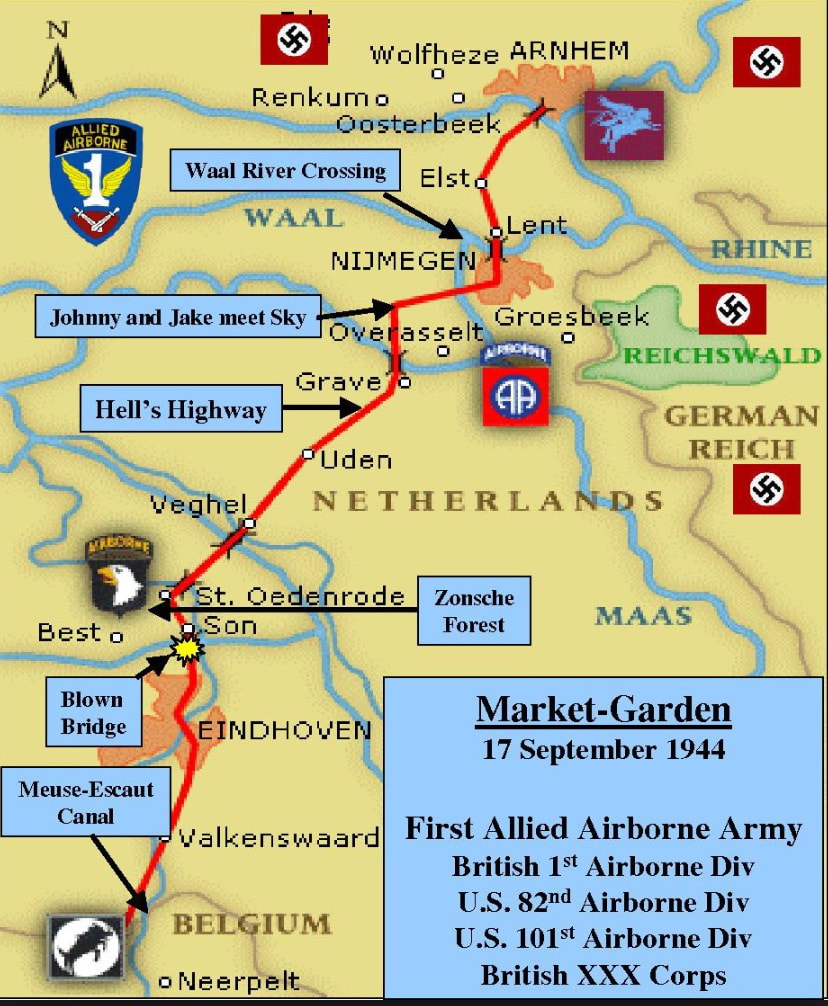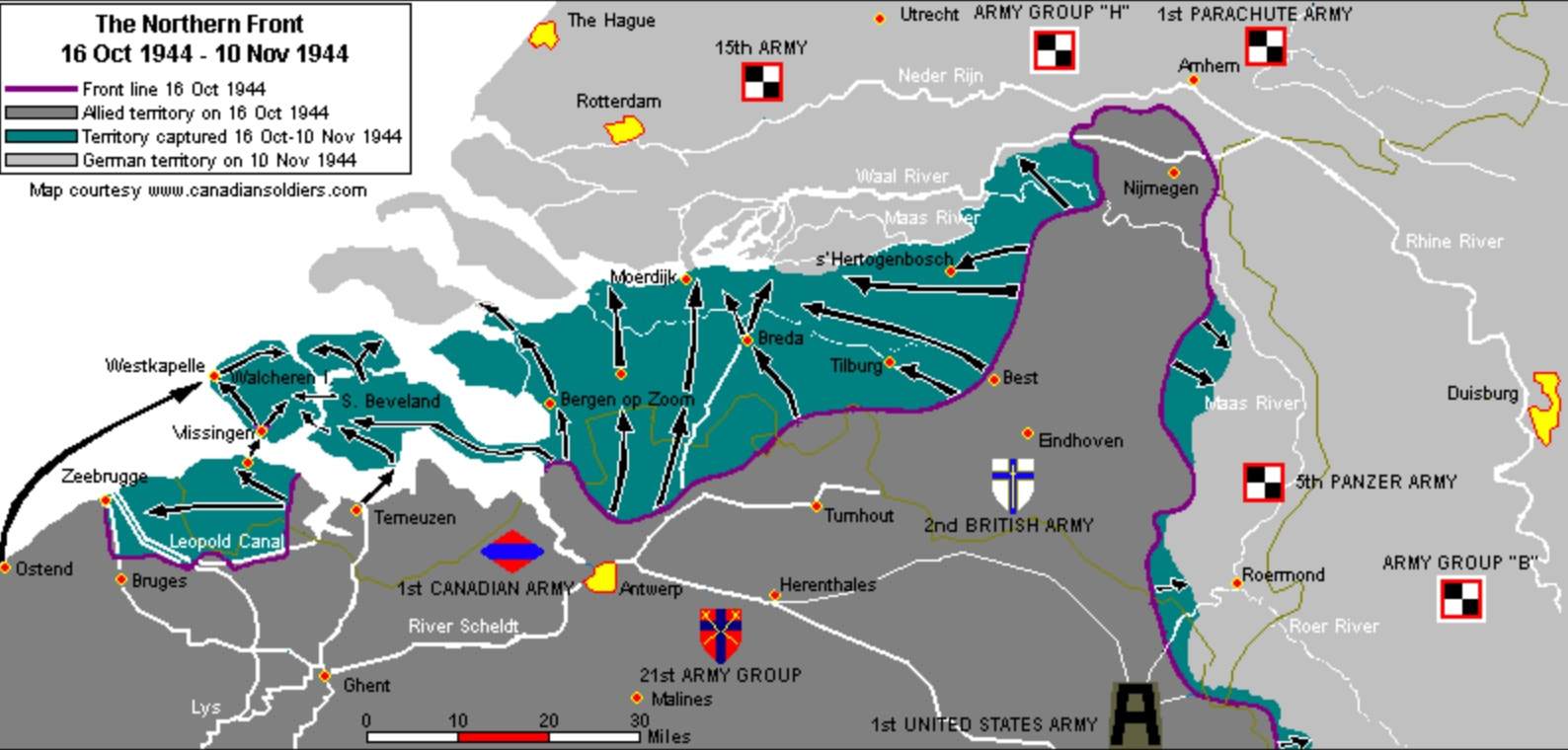bigpigeon.us webpage WWII Germany > The ETO > War of Attrition > Netherlands, 1944, © 2023 by Robert A. Christiansen, updated by RAC 30 Dec 2023.
In early September 1944, Allied forces advancing northward from France liberated almost all of Belgium, including the key port of Antwerp. However, most of the Netherlands to the north was not liberated until the spring of 1945.
In early September 1944, Allied forces advancing northward from France liberated almost all of Belgium, including the key port of Antwerp. However, most of the Netherlands to the north was not liberated until the spring of 1945.
The Netherlands lay in the northern sector of the ETO, where Allied forces were primarily British and Canadian. Polish forces and for a time four US divisions also fought in the Netherlands.
During the War of Attrition in the fall of 1944, Allied forces secured portions of the southern Netherlands via three major operations:
During the War of Attrition in the fall of 1944, Allied forces secured portions of the southern Netherlands via three major operations:
- Operation Market Garden, the attack north through the southern Netherlands in an effort to access the North German Plain via Arnhem. Although Arnhem couldn't be held, Market Garden created an Allied-held salient reaching to just north of Nijmegen.
- The clearing of German forces from the Scheldt Estuary area between the North Sea and Antwerp. This allowed the development of Antwerp as the major ETO port.
- The advance eastward from the Nijmegen Salient to the Maas River (called the Meuse in France and Belgium).
|
The Netherlands 1944 Timeline:
|
Part 1 - Operation Market Garden
|
Operation Market Garden was an Allied attempt to seize bridges across the lower Meuse/Maas, Waal, and Rhine Rivers to outflank the northern end of the Siegfried Line. If successful, Market Garden would had allowed access to the North German Plain, across which Allied armor could then sweep.
Market Garden consisted of elements of the British XXX Corps attacking from northern Belgium up the highway through Eindhoven, coupled with three parachute drops. Other Second British Army elements provided flank protection. Market Garden failed to capture the northernmost bridge, at Arnhem. However, the attack created a salient, which I call the Nijmegen Salient, which remained in Allied hands. Market Garden began on 17 September and ended with the surrender of British and Polish paratroopers at Arnhem on 25 September 1944. |
Part 2 - Clearing the Scheldt Estuary
|
Antwerp, the largest port in Europe at the time, is in Flanders in northwest Belgium, connected to the North Sea by the 49-mile Scheldt estuary.
The British Second Army captured Antwerp on 4 September. The clearing of the Scheldt Estuary of German forces was done by the Canadian First Army, beginning on 2 October and ending on 10 November. Once cleared of Germans, a shipping channel needed to be cleared of mines. The first convoy of Allied ships arrived in Antwerp harbor on 29 November. |
The opening of the port of Antwerp did much to resolve the supply shortages that had plagued the ETO since early September. Antwerp was much closer to the front lines than the major ports previously used, such as the artificial Mulberry Harbor on the Normandy invasion beaches, Cherbourg at the tip of the Normandy peninsula, and Marseille on the Mediterranean in southern France.
Antwerp was a major target of German V-2 rockets, which were first used on London on 8 September 1944. Over half of V-2 rockets were directed at Antwerp. Between October 1944 and March 1945, over 700 Allied military personnel and 3,400 Belgian civilians died in Antwerp and the immediate surrounding area from German V-1 and V-2 attacks.
Antwerp was a major target of German V-2 rockets, which were first used on London on 8 September 1944. Over half of V-2 rockets were directed at Antwerp. Between October 1944 and March 1945, over 700 Allied military personnel and 3,400 Belgian civilians died in Antwerp and the immediate surrounding area from German V-1 and V-2 attacks.
Part 3 - Expanding the Nijmegen Salient
|
As the Canadian First Army cleared the lowlands along the Scheldt Estuary, the British Second Army provided flank protection by expanding the Nijmegen Salient as shown in the accompanying map. Some of the deadliest WWII combat in the Netherlands occurred during German attacks against the east flank of the Nijmegen Salient.
|
The accompanying map shows progress as of 10 November. By 16 December, Allied lines on the east followed the Maas/Meuse River.
Sources for Big Pigeon's The ETO > War of Attrition > Netherlands, 1944 webpage:
Major Sources:
Pottawattamie Area WWII Dead - The ETO > War of Attrition > Netherlands, 1944:
Major Sources:
- None at this time.
- The header photo of British prisoners of war at Arnhem in the failed September 1944 Market Garden operation is courtesy of argunners.com, an on-line war history magazine.
- The Southern Netherlands map is courtesy of nationsonline.org and found at https://www.nationsonline.org/oneworld/map/netherlands_map.htm.
- The Scheldt Estuary map is taken from the Canadian publication The clearing of the Scheldt Estuary and the liberation of Walcheren.
- Expanding the Nijmegen Salient
Pottawattamie Area WWII Dead - The ETO > War of Attrition > Netherlands, 1944:
- Taken from the bigpigeon.us WWII Dead module.
- Most Allied dead in ETO operations in the Netherlands were British, Canadian, or Polish.
- Co. A, 506th Parachute Inf. Regt., 101st Airborne Div.; KIA 6 Oct 1944 Opheusden, NW of Nijmegen, Netherlands; direct hit by an artillery shell on his machine gun position; Battle of Opheusden - The ETO > War of Attrition > Netherlands 1944.
- Co. A, 501st Parachute Inf. Regt., 101st Airborne Div.; KIA 17 Sep 1944 over Retie, 30 miles E of Antwerp, Belgium; Douglas C-47A Skytrain/Dakota #42-100981 shot down by flak; all 15 dead (five crew and ten army airborne pathfinders heading for the Operation Market Garden drop zone N of Eindhoven, Netherlands); Operation Market Garden - The ETO > War of Attrition > Netherlands 1944.
- original member of Co. A, 508th Parachute Inf. Regt., 82nd Airborne Div., organized 4 Nov 1943 at Camp Mackall,, NC; parachuted from burning C-47A #42-101004 near Groesbeek, Netherlands 17 Sep 1944; KIA 19 Sep 1944 near Nijmegen, Netherlands; Battle of Nijmegen phase of Operation Market Garden - The ETO > War of Attrition > Netherlands 1944.
- Co. A, 23rd Armored Inf. Bn., 7th Armored Div., Ninth Army, attached to British VIII Corps, British Second Army; KIA 28 Oct 1944 near Neerkant, E of Eindhoven, North Brabant, Netherlands; The ETO > War of Attrition > Netherlands 1944.








